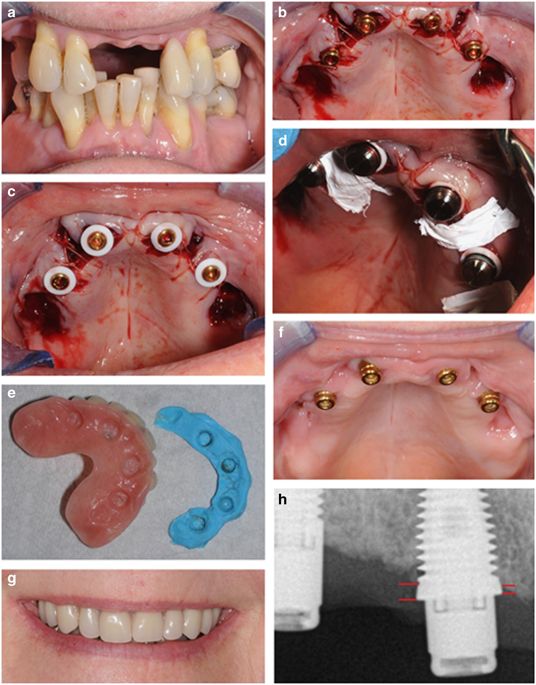BDJ Open ( IF 2.5 ) Pub Date : 2017-09-08 , DOI: 10.1038/bdjopen.2017.17 David Offord 1 , Grant Mathieson 1 , Nicola Kingsford 1 , Carine Matthys 2 , Maarten Glibert 2 , Hugo De Bruyn 2

|
Objectives/Aims:
The primary aim of this retrospective pilot study was to evaluate the clinical outcome of overdentures on four non-splinted maxillary implants compared to the mandible using locator attachments and secondly to assess patient's opinion of the treatment.
Materials and Methods:
The treatment protocol used here is summarised as a single-stage surgical approach followed by immediate loading (same day in 12 of 17 patients) of a removable prosthesis in the maxilla and mandible. Most of the implants were installed into fresh extraction sockets. Clinical outcomes were evaluated in 68 southern implants, straight (non co-axis) or angulated (co-axis) in 17 patients. Patients were examined by independent examiners at an average follow-up of 14.5 months after implant placement.
Results:
Outcomes measured were implant survival, bone loss, bleeding on probing, probing pocket depths and plaque score in addition to quality of life measured with OHIP-14 questionnaires. An overall implant survival of 100% was achieved. The mean marginal bone level (mm) over the entire cohort of 66 measured implants was (1.4 mm; range, 0–5.5). A significant difference (P=0.01) was found between bone level, from implant head to bone contact in the maxilla (M, 0.9 mm; s.d., 1.1; range, 0–4) and the mandible (M, 1.7; s.d., 1.0; range, 0–5.5). The marginal bone-to-implant head distance with the angulated co-axis implants was 1.9 mm (s.d., 1.5; range, 0–5.5) compared to non co-axis, mean 1.2 mm (s.d., 1.1; range, 0–4) (P=0.01). The OHIP-14 overall mean was 3.3 (out of a maximum of 56).
Conclusion:
The implant survival was 100% and the patients benefited from the overdenture treatment on four non-connected implants. The extremely low OHIP-14 indicated a very high level of patient satisfaction following treatment. The results of this study merit further long-term investigation to fully investigate the success of immediately loading implants in the maxilla as well as cost-benefit.
中文翻译:

下颌和上颌种植体支持覆盖义齿的种植体周围健康、临床结果和以患者为中心的结果
目标/目的:
这项回顾性试验研究的主要目的是评估四个非夹板式上颌种植体上覆盖义齿与使用定位器附件的下颌骨相比的临床结果,其次是评估患者对治疗的意见。
材料和方法:
此处使用的治疗方案总结为单阶段手术方法,然后在上颌骨和下颌骨中立即加载(17 名患者中有 12 名患者在同一天)。大多数植入物被安装到新鲜的拔牙窝中。临床结果在 17 名患者的 68 个南方种植体中进行了评估,直(非共轴)或成角度(共轴)。植入物植入后平均随访 14.5 个月,由独立检查员对患者进行检查。
结果:
除了使用 OHIP-14 问卷测量的生活质量外,测量的结果还包括种植体存活率、骨丢失、探诊出血、探诊袋深度和斑块评分。实现了 100% 的整体种植体存活率。整个 66 个测量种植体队列的平均边缘骨水平 (mm) 为 (1.4 mm;范围,0-5.5)。从种植体头部到上颌骨(M,0.9 mm;sd,1.1;范围,0-4)和下颌骨(M,1.7;sd,1.0)的骨水平之间存在显着差异(P = 0.01) ; 范围,0–5.5)。有角度的同轴种植体的边缘骨到种植体头部距离为 1.9 毫米(标准差,1.5;范围,0-5.5),而非同轴种植体平均为 1.2 毫米(标准差,1.1;范围,0-4 ) ( P =0.01)。OHIP-14 的总体平均值为 3.3(最大值为 56)。
结论:
种植体存活率为 100%,患者受益于四个非连接种植体的覆盖义齿治疗。极低的 OHIP-14 表明治疗后患者的满意度非常高。这项研究的结果值得进一步长期调查,以全面调查在上颌骨中立即加载种植体的成功以及成本效益。











































 京公网安备 11010802027423号
京公网安备 11010802027423号